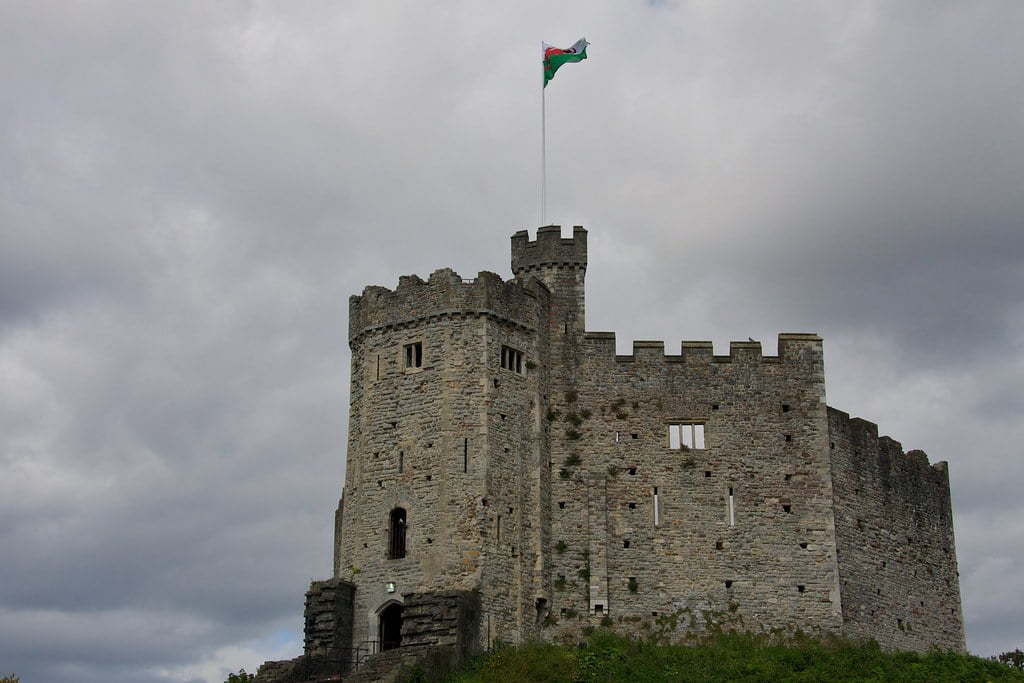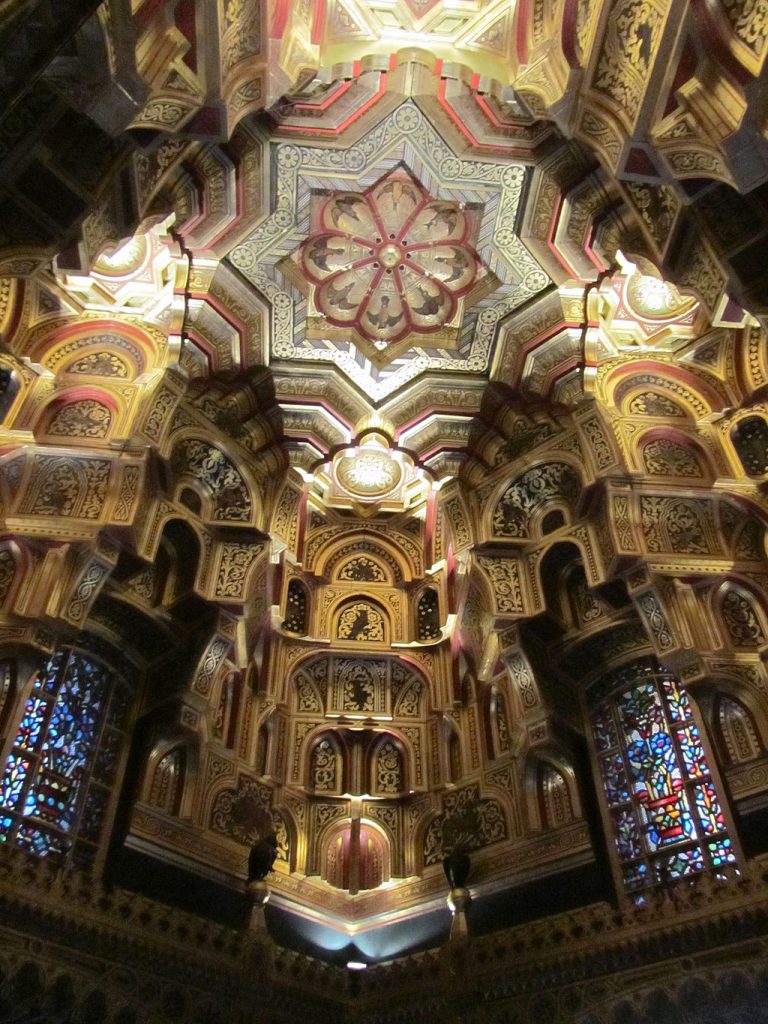Cardiff Castle, located in the middle of Wales’ largest city, is a Roman fort turned Medieval fortress-castle turned Neo-Gothic wonder–well worth a visit for its architectural charm alone. But this castle has also passed through the hands of some of Britain’s most notable families & stands to tell the stories of a long past. This is the castle to visit for experiencing Welsh history unfold around you, read on for information about the castle and visiting it!
Table of Contents
Cardiff Castle was one of those castles with the sanitarily questionable method of having garderobes, essentially toilet-hole nooks, that emptied over the moat.

Frequently Asked Questions
Where is Cardiff Castle Located?
Cardiff Castle is located in the city center of Cardiff–one of the larger cities along the southern edge of Wales.
When was Cardiff Castle Built? Who Build It?
The earliest archeological evidence is of a 3rd-century Roman fort; the stone castle was built through the late eleventh to early thirteenth centuries by Norman invaders.
When is The Best Time to Visit the Castle?
Cardiff Castle has appeal no matter what time of year you chose to visit, but note that Welsh winters can be quite cold and wet.
What Other Monuments are Located Nearby?
National Museum Cardiff is in downtown Cardiff, as well as Principality Stadium, home of the Welsh rugby team if you are more sports-inclined. Cardiff Bay & Roath Park are great areas to visit for getting outdoors but, a little farther out of downtown, don’t miss Castell Coch and St. Fagans Museum of History.
FOR HISTORY | BEAUTIFUL IMAGES | INTERESTING FACTS | TRAVEL TIPS
Early History
Romans & Normans
Somewhere around 55 CE, the very first fort on the current Cardiff Castle’s grounds was built. Most likely occupied until 80 CE, it was followed up by another couple of smaller forts until the late 3rd century when a pirate threat started threatening the Romans’ hold on the area. At that time, the castle/fort site would have been directly overlooking the harbor instead of the center of town as it is today. The fort would have been occupied for at least a century until the Romans began departing the area, with no major signs of habitation uncovered between then and the Norman invasion.

A moat-&-bailey style castle wouldn’t be raised for another 800 years until at least a couple of decades after the Norman invaders began pushing into Wales in the 1060s. Nonetheless, the very first “castle” was most likely still a timber construction, with the outer walls being built on the collapsed remains of the Roman fort. The surrounding lands were split into “knights’ fees”, given out on the condition that the knights maintain houses in the castle’s outer bailey and come to the castle’s defense when needed. Cardiff Castle at this time was a Marcher Lord, meaning that in return for protecting the line between more rural Wales (still largely under Welsh control) & Norman-dominated England, the resident lord of the castle enjoyed special privileges and a certain amount of freedom from the English Crown.
Host to the Royal Extras
Of course, that also meant the crown tended to appoint particularly loyal lords, such as Henry I’s appointment of his own (illegitimate) son, Robert of Gloucester, in 1122. This is probably when Cardiff Castle took form in stone, with increased defenses built in as well. The building project is hypothesized to have started in response to the Welsh uprising in 1136. Because of its prominent location, Cardiff Castle continued to play a key role throughout the next centuries in the struggles between the Welsh and Normans, who left their mark in the form of castles all across England.

Robert of Gloucester passed the castle to his son, William Fitz Robert. William was taken hostage by Welshman Ifor Bach for a time in 1158, followed by another attack in 1183. The next year, the town walls of Cardiff had been built with the West Gate constructed in the gap between the castle and river (which had already moved some since the Roman period).
When Fitz Robert died in 1183 leaving only three daughters, Henry II made an exception to the typical inheritance customs of the time. He allowed William’s daughter Isabel to inherit the castle and lands. It seemed like a forward-thinking move … until Henry II married Isabel to his youngest son Prince John. He promptly took control of the castle and lands, retaining control after he divorced Isabel. Isabel remarried to Geoffrey de Mandeville and her inheritance passed to his control. When Isabel died childless three years later, the castle passed to her nephew, Gilbert de Claire. The de Claire family reinforced the castle defenses–including building the Black Tower–as they faced off with the native Welsh prince Llywelyn ap Gruffudd. This was long before the title Prince of Wales was an English inheritance.

Six Hundred Years
From the de Claires, Cardiff Castle passed through a number of influential families. The Despencers, the Beauchamps, the Nevilles, the Tudors, the Windsors (long before they became a reigning house), and finally, the Butes each made their mark on the castle.
As a side note to the castle’s history but of note overall, Cardiff Castle passed between the Nevilles and the Tudors during the War of the Roses. It never actually came into militant importance during this time. Nonetheless, it was the Tudors’ ascension to the English throne from their Welsh roots that helped ease Welsh-English relations. It also instigated the use of the “Prince of Wales” title for the English crown’s heir.

After six hundred years of apparent stability, the 1st Marquess of Bute had the main range renovated into a Georgian-style manor house. His son, the 2nd Marquess of Bute, made Cardiff a notable coal exporter and built a fortune in the process. In 1866, under John, 3rd Marquess of Bute that legacy was put to good use overhauling the manor again. Stained glass windows, murals, marble, ornate carvings, and opulent gilding created a fanciful Neo-Gothic castle. The project was completed by the 4th Marquess.
Revisit More Historic Places Below or Read Further
Current Times
The 4th Marquess of Bute also oversaw Cardiff Castle during WWII, when it again played the part of a defensive fortress–albeit slightly differently than the medieval style. Tunnels built into the walls of Cardiff Castle were used as bomb shelters. They could host around 2,000 civilians when the sirens sounded.
After the 4th Marquess’ death, the Bute family passed the castle to the City of Cardiff. Through the mid-20th century, Wales’ National College of Music and Drama resided at the castle. It was opened as a tourist attraction in 1974.

Interesting Cardiff Castle Facts
- The remains of the Roman walls can still be seen inside the castle grounds.
- Cardiff Castle was one of those castles with the sanitarily questionable method of having garderobes, essentially toilet-hole nooks, that emptied over the moat.
- Richard de Beauchamp renovated the octagonal building at Cardiff Castle around 1423.
- The architect, William Burges, that worked on Cardiff with the 3rd Marquess of Bute was considered an “eccentric genius”.
- The Bute remodel introduced different themes per room, including Mediterranean, Arabian, & Italian.
Visiting Cardiff Castle – Tips and Tricks
Cardiff Castle is a wonder of multiple ages in one location, an exciting adventure through time. Here is some practical information to help your visit go as smoothly as possible!

How to get to Cardiff Castle?
Cardiff Castle is in the center of Wales’ capital and largest city. It is only a ten-minute walk from the two largest train stations in the city: Cardiff Central & Cardiff Queen Street.
The joy of traveling in the United Kingdom is that it is very easy to get around from big city to big city. Cardiff is only 2 hours away from London (Paddington Station) by train for £50-70 ($70-$90 USD). Take either train or bus for an hour’s travel from Bristol (Temple Meads Station) for £10-£110 ($10-$150). A 4.5 hours train ride from Liverpool (Central Station) will cost £70-140 ($100-$200 USD). You could also travel from Edinburgh, Scotland through England to Cardiff in only 8 hours by train for £140-£530 ($190-$720 USD) or 14 hours by bus at £30-£140 ($50-$180 USD).
Ticket Prices, Visiting Hours & Travel Tips
Information was checked & updated on October 31, 2023.
Baring special events, Cardiff Castle is open every day except December 25th & 26th, and January 1st. Summer hours, observed from March to October, are 10 am to 6 pm Monday-Thursday & 9 am to 6 pm Friday-Sunday. Between November and February, the castle closes at 5 pm on weekends instead. The last entry is consistently one hour before closing, year-round.
Ticket prices are £14.50 ($16 USD) for adults; £10 ($14 USD) for accompanied children, ages 5-16; and £10 ($12 USD) for students, seniors, and the disabled. Family tickets for two adults & two children are available for £39 ($41 USD), or £35 ($37 USD) for two seniors & two children. Children under 5 and a disabled visitor’s caretaker enter for free.
There are a number of guided tours available at Cardiff Castle that cover a range of interests, from storytelling in the Black Tower to the gear works of the Clock Tower. There is also a 90-minute in-depth tour that requires pre-booking. It is also possible to book a traditional Welsh banquet experience. The availability of these activities is in flux currently due to Covid. Please visit the official website for exact information.

How Long Will It Take to Tour Around?
Cardiff Castle can easily hold your attention for at least 2 hours. Plan for longer if you intend to explore every nook and cranny!
Up to Date Information
For up to date ticket prices and visiting hours visit the official website: https://www.cardiffcastle.com
Some words of advice and tips:
- The Castle Cafe has hot drinks or cooling refreshments, depending on your taste & the season, should you get hungry during your castle explorations!
- While non-commercial (personal) photography is welcome in the castle, flash photography & selfie-sticks/tripods are not.
- Pets are welcome in the Public Square but not inside the historical buildings.
Do you want to see more unique and interesting castles to visit? Read our list of the best castles in Wales.



